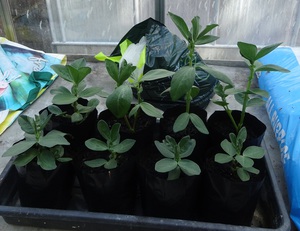With our moving into May, it seems high time for another update to the project.
Our beans are growing nicely – and showing the differences you can get in plant shape / size from within the same set of beans. We’ve got little squat ones or very long leggy ones coming up from the same packs, so don’t worry if yours are all a bit different.
You will need three plants that are similar in appearance for the project, but they don’t need to be identical in every way - just about the same size so they have about the name number of flowers, and similar leaf area. It’s probably getting on for putting them outside if you haven’t already, so here are a few points to remember:
1) If your beans are getting tall, it will probably be worth tying them to sticks to make sure that the wind doesn’t break or bend the stems.
2) Watering is going to start being more of a concern. Twice is week is probably enough, but do keep an eye on them – any wilting, give them a quick slosh!
3) Being outside does mean that we are likely to have to contend with pests:
Aphids might attack your plants. These should not be a problem, but if you think they are, any standard aphid removal method will work (we have washed one plant with slightly soapy water, and squashed any escapees).
Mice are probably not going to be interested in the growing plants (although some of you lost seeds to them). If you think you are having mouse issues, again, any standard method should be fine. Apparently tea-tree oil is quite a good mouse-deterrent.
Slugs and snails. Probably going to be your biggest problem. We are keeping our beans raised over a trough of water, which slugs and snails won’t pass. You could also use copper tape (expensive though), surrounding the plants with sharp sand (to deter marching), or organic slug pellets.
Or chopping the offending molluscs in half with a trowel if you see them (which is my preferred method).
If you do see slug damage on the plants, then it is a good idea to carefully lift up the pots and have a look underneath – often you can find the perpetrator just out of sight and can deal with it appropriately. Thankfully, garden birds are very keen on mashed slug!
Blackfly. This should not be a problem now (might become one later) but it is worth keeping an eye out for black aphids, particularly around the growing tips of the plant.
4) I would like to apologise for the amount of mold that we have been seeing on these beans – this is above what I was expecting from previous experience, and is something I will be taking up with the seed supplier. Thankfully it does not seem to have done much harm to the beans, but it doesn’t look good – so thanks to everyone for persevering through the occasional green-fuzz moment!
If our beans progress as we hope, we should be seeing the first flowers starting towards the end of this month (people further north than Brighton may well take a bit longer of course!)